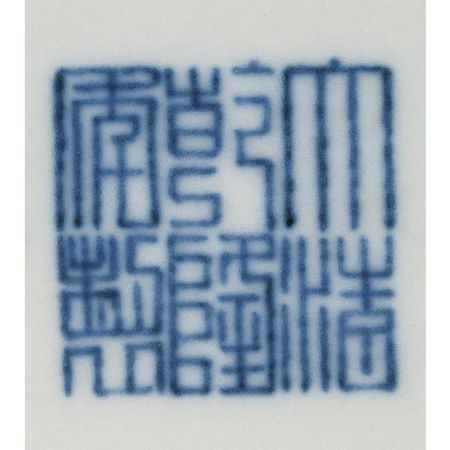A finely painted and rare copper-red decorated 'nine dragon' moonflask. Seal mark and period of Qianlong
A finely painted and rare copper-red decorated 'nine dragon' moonflask. Seal mark and period of Qianlong. Photos Courtesy Sotheby's
the finely potted body of flattened globular form, superbly painted in vivid ruby tones of copper-red enhanced by simulated 'heaping and piling', one side decorated with a leaping five-clawed horned dragon entwining a central 'flaming pearl' surrounded by four further ferocious dragons, the reverse with four dragons in pursuit of a further 'flaming pearl' in the centre, the beasts with undulating scaly bodies flying amid a scatter of vaporous clouds and above crashing waves, the shoulder flanked by a pair of handles with ruyi designs reaching up to the slightly waisted neck decorated on each side with hovering bat, with a band of ruyi heads below the rim, the base inscribed with the six-character seal mark in underglaze-blue - 25.6 cm., 10 in. - Lot Sold: 9,620,000 HKD
PROVENANCE: Acquired in the 1970s from a Portobello Road dealer who bought it previously from a West country dealer in Cornwell.
Thereafter with the present owner.
NOTE: Vessels decorated in underglaze copper-red are extremely rare and even rarer are those in the form of moonflasks. Only one other similar flask appears to be recorded, although slightly larger in size, sold in these rooms, 1st May 2001, lot 538.
The present flask belongs to a very small and special group of imperial Qianlong vessels painted in this style with copper-red dragons amongst clouds above waves. Compare for example, two vases from the Qing Court collection and still preserved in Beijing, illustrated in The Complete Collection of Treasures of the Palace Museum. Blue and White Porcelain with Underglaze Red (III), Shanghai, 2000, pls. 174 and 178; and a pair of double-gourd vases, also in the Forbidden City, Beijing, on display in the Suianshi (Room of Finding Peace) in the Yangxin Dian (Hall of Mental Cultivation) published in situ in Life in the Forbidden City, Hong Kong, 1985, pl. 177.
Another double-gourd vessel with similar five-clawed dragons, from the collection of T.Y. Chao, was included in the exhibition Ming and Ch'ing Porcelain from the Collection of the T.Y. Chao Family Foundation, Hong Kong Museum of Art, Hong Kong, 1978, cat. no.781.
Qianlong flasks of comparable form and size, but painted with the design of a sparrow perched on a prunus branch in copper-red were also made for the court in the Imperial Kilns at Jingdezhen, Jiangxi province. For example, see a flask illustrated in The Complete Collection of Treasures of the Palace Museum. Blue and White Porcelain with Underglaze Red (III), Shanghai, 2000, pl. 177; another offered in our London rooms, 21st June 1983, lot 345; and a third flask, from the collections of L. Wannieck and J. R. May and now in the Rijksmuseum, Amsterdam, also sold in our London rooms, 8/9th July 1974, lot 279. A blue-and-white version of the 'sparrow and prunus branch' flask, from the de la Mare collection, was sold in our London rooms, 2nd April 1974, lot 369. Blue and white flasks of similar form, size and handles can also be found decorated with flowers and fruits; see a flask in the National Palace Museum, Taipei, included in the Blue-and-white Ware of the Ch'ing Dynasty, Book II, Hong Kong, 1968, pl. 16.
Qianlong period moonflasks painted with a single large front-facing dragon are also known decorated in underglaze-blue and underglaze-red. See a slightly larger flask of closely related form and handles included in The Complete Collection of Treasures of the Palace Museum. Blue and White Porcelain with Underglaze Red (III), op.cit., pl. 213. Compare also a larger blue-and-white moonflask, with a Qianlong reign mark and of the period, with elaborate dragon-form handles and painted with a ferocious front-facing dragon, published ibid., pl. 132; and another vessel of this type decorated with the 'dragon and phoenix' design sold in these rooms, 23rd October 2005, lot 212.
The form of the present flask is an adaptation of much earlier foreign pilgrim bottles made of leather. During the Tang dynasty they became the inspiration for ceramic replicas. It is thought that they were made to contain wine. Qing moonflasks, especially blue-and-white vessels, were largely derived from the Ming prototypes. See a Yongle blue-and-white moonflask of this size and shape, painted with flower scrolls, sold in our London rooms, 9th November 2005, lot 291; and another with the same flower scroll motif, from the former collection of the Ottoman sultans in Istanbul, and fitted with an Ottoman silver-gilt rim mount, illustrated in Regina Krahl, Chinese Ceramics in the Topkapi Saray Museum, Istanbul, vol. II, London, 1986, pl. 613.
The number nine (jiu) in China is considered the highest yang or male principle number and is the homonym for the word 'eternity'(jiu). The dragon is the symbol of the emperor, and the motif of 'nine dragons' represents the wish for eternal generations of rulers and the desire that 'all members of the Imperial family live in eternal harmony together'. The nine-dragon motif can be found on a number of Qianlong vessels, including the blue-and-white meiping with the dragons in underglaze-red, in the Palace Museum, illustrated in the The Complete Collection of Treasures of the Palace Museum. Blue and White Porcelain with Underglaze Red (III), op.cit., pl. 205.
Sotheby's. Legacies of Imperial Power: Treasures from the Imperial Collection. 08 Oct 08 Hong Kong - www.sotheby's.com

/https%3A%2F%2Fprofilepics.canalblog.com%2Fprofilepics%2F1%2F0%2F100183.jpg)
/https%3A%2F%2Fstorage.canalblog.com%2F03%2F02%2F119589%2F96711876_o.jpg)
/https%3A%2F%2Fstorage.canalblog.com%2F11%2F31%2F119589%2F94773502_o.jpg)
/https%3A%2F%2Fstorage.canalblog.com%2F20%2F83%2F119589%2F94772815_o.jpg)
/https%3A%2F%2Fstorage.canalblog.com%2F26%2F72%2F119589%2F75604929_o.jpg)
/https%3A%2F%2Fstorage.canalblog.com%2F59%2F60%2F119589%2F26458628_o.jpg)






/http%3A%2F%2Fstorage.canalblog.com%2F88%2F26%2F119589%2F129337200_o.jpg)
/http%3A%2F%2Fstorage.canalblog.com%2F51%2F59%2F119589%2F128976423_o.jpg)
/http%3A%2F%2Fstorage.canalblog.com%2F30%2F27%2F119589%2F128677718_o.jpg)